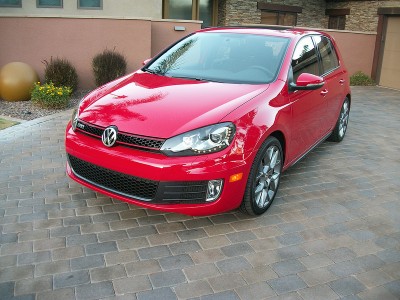 I don’t buy modern cars these days, because between press cars and the small flock of Mercedes diesels that tend to follow me home, there just isn’t the need. But it’s pretty inevitable at a party, someone will ask me “What car would YOU buy today?” or “What was the first new car that you bought?” And the answer’s pretty much the same: the Volkswagen GTI.
I don’t buy modern cars these days, because between press cars and the small flock of Mercedes diesels that tend to follow me home, there just isn’t the need. But it’s pretty inevitable at a party, someone will ask me “What car would YOU buy today?” or “What was the first new car that you bought?” And the answer’s pretty much the same: the Volkswagen GTI.
I was a recent U of M graduate in a terrible job market when the first US Market GTI made its appearance in the fall of ‘82. Made in Westmoreland, it had several key changes from the Euro version and had to overcome the “Americanized” image that was diluting the Rabbit’s market appeal. To say that it did was an understatement. I was enchanted with that snarky, sassy little hot hatch and had to have it. Finally one showed up at the local VW Dealer — it was black with a sunroof and was built on the fourth day of production. I was toast. It was the first new car I bought for myself. And I miss it more than any car I’ve ever owned.
I was piling up tons of miles on it, so I decided to trade it for a second-gen ‘1985. Longer wheelbase, more sophisticated, understated Teutonic interior, and actually faster but didn’t seem it. I liked it a lot but didn’t adore it — and ultimately went to work for a Big Three company that frowned upon it.
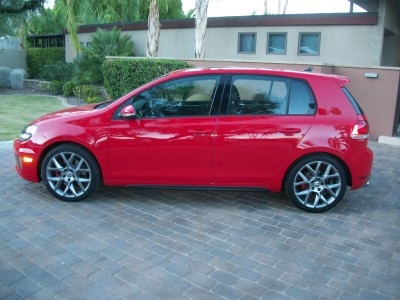 So with all the VWs I’ve driven in the last couple of years, I’ve noted that they tend to remind me of the GTI, so I asked for one to test, almost exactly 30 years later.
So with all the VWs I’ve driven in the last couple of years, I’ve noted that they tend to remind me of the GTI, so I asked for one to test, almost exactly 30 years later.
My test car was a German-assembled Tornado Red four door with sunroof, Nav, and DSG dry-clutch automatic, and from the first twist of the key, it made me smile as if 30-years-ago me were driving it. Of course, everything is different, and much more advanced, but it’s downright surprising how familiar it all feels.
Let’s start with the shape. Yes, it’s more aerodynamic now and the LED-accented projector headlamps are pretty hard to ignore, but basically it’s the same red-accented box-on-a-box hatchback shape it’s been all along. The wheels are bigger and the tires are meatier — they’re now 18s — but squint just slightly and it’s still a GTI.
That familiarity extends to the interior as well. The plaid fabric is homage to the original German GTI — both of mine had 80s strobe fabric — but the thickly bolstered seats are instantly familiar, as is the whole driving position, including the shift linkage and steering feel. It fit like a glove. It seemed perfectly appropriate to set the Sirius radio to 80s on 8 and leave it there until the accountants at VW cut the subscription off in mid-test. It couldn’t be that they didn’t dig the tunes.
It may be familiar, but of course it’s really all modern. The 2.0-liter TSI engine develops 200 hp and 207 ft-lbs of torque, more than twice that of the original. It can do 0-60 in about seven seconds, which is light years ahead of the original’s 10 seconds, and it features electric power steering and traction control and stability control and cross differential control all the other modern conveniences that we can’t do without, although we never used to know we even needed them.
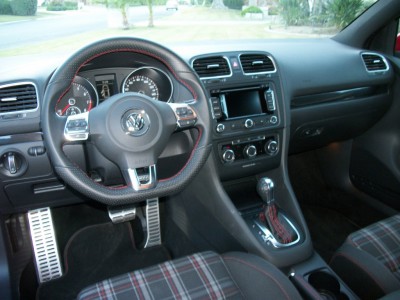 The test car came equipped with VW’s DSG dual-clutch automatic, which was a point of controversy. I’ve always had manuals in my GTIs and would have preferred the six-speed stick, but the DSG was all that was available for my Oprah moment. And to me, it’s about as much fun as having Aunt Marybelle sitting next to me, watching: it likes to keep revs under 3,000 and is always about two gears ahead of where I would like.
The test car came equipped with VW’s DSG dual-clutch automatic, which was a point of controversy. I’ve always had manuals in my GTIs and would have preferred the six-speed stick, but the DSG was all that was available for my Oprah moment. And to me, it’s about as much fun as having Aunt Marybelle sitting next to me, watching: it likes to keep revs under 3,000 and is always about two gears ahead of where I would like.
Thankfully, there are two solutions: the Sport mode holds the gears much longer but constantly wants to play chicken with your right foot. Basically, it won’t upshift unless you lift off the throttle, which is more distracting than just slapping it over into manual mode and shifting the damn thing yourself. I must admit that if I still lived in LA, I’d probably go DSG, but otherwise I’d save myself $1,100 and just opt for the six-speed.
As a follow up, VW managed to get me a six-speed stick Jetta GLI for comparison. It was exactly what I expected: short, precise shifts and a feeling of absolute control that the DSG never quite yields. Kudos to VW for the six-speed, it only confirmed my preference for the stick.
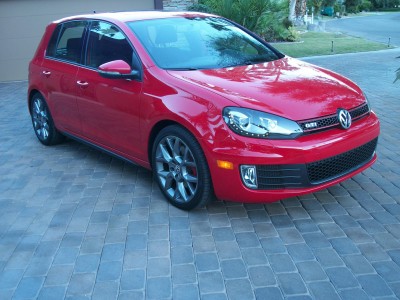 And once on the road, it drove like a GTI should: long revving (especially in Sport mode), quick handling, surefooted and absolutely glued to the road. The best attribute is everything — it’s just such a well-balanced and pleasurable machine. A special shout out to the brakes, which feature vented rotors in front and solid ones behind, but had a super responsive feel and brought the little screamer down quickly and with excellent feel.
And once on the road, it drove like a GTI should: long revving (especially in Sport mode), quick handling, surefooted and absolutely glued to the road. The best attribute is everything — it’s just such a well-balanced and pleasurable machine. A special shout out to the brakes, which feature vented rotors in front and solid ones behind, but had a super responsive feel and brought the little screamer down quickly and with excellent feel.
Thirty years ago, VW brought the hot-hatch to America with the GTI, a snarky performance car that you could strap two car seats into and enjoy your daily commute. The car has certainly changed over the years, but the mission hasn’t. Three decades later. GTI is still the one in my book.
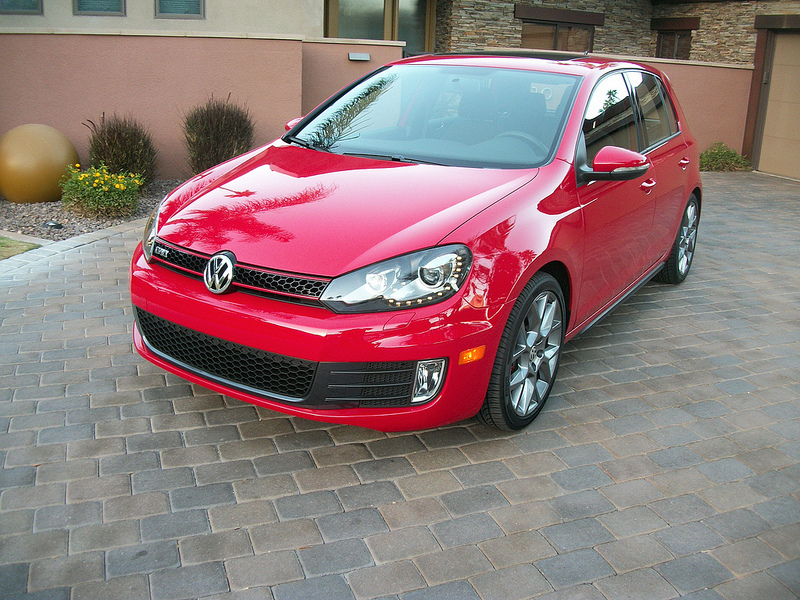
Oh god . . . the Westmoreland VW Rabbit was the worse thing ever made. I know; I had one for two years.
Here in Europe, Golf, or Rabbit as you call it overseas is considered a brilliant model. To me – trash.
You are a crazy kraut
All of you Europeans are stupid pussies, that’s why that old ass queen owns you all haha. Bend right over and keep giving your guns up, the Allied Forces will have to save your stupid asses again